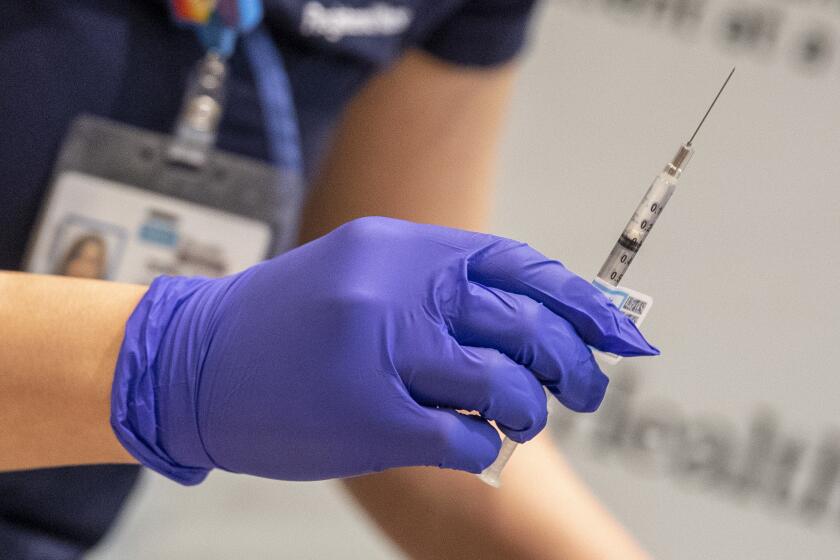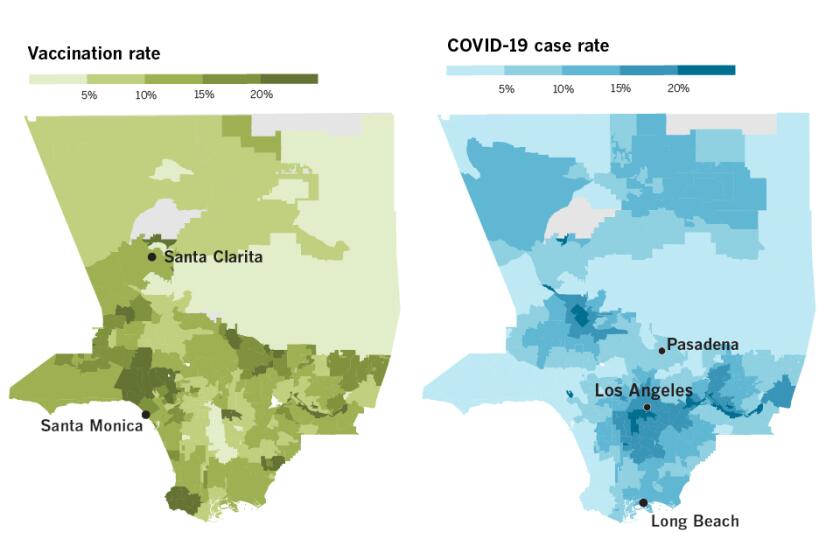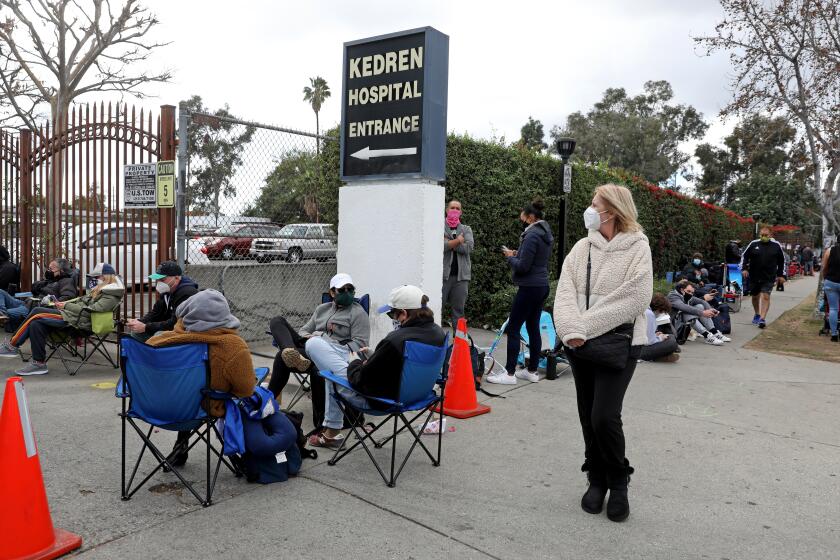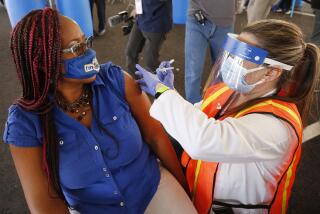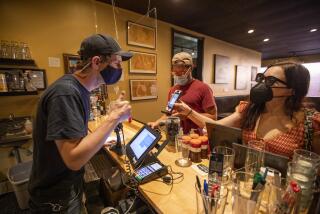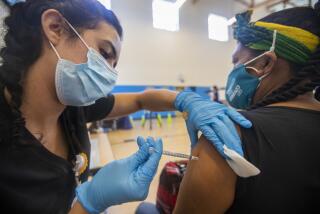Column: Of course, Californians misused vaccine codes. The system is designed for cheating

- Share via
If there has been one constant in California’s roller-coaster rollout of its COVID-19 vaccination program, it has been the cheaters. The vaccine chasers — many of whom have the luxury of working from home — who aren’t yet eligible under the state’s rules, but still exploit every angle to get themselves shots, often hogging doses meant for vulnerable Angelenos.
And as my colleague Julia Wick reported, they’ve struck again — this time intentionally or ignorantly using what were supposed to be secret access codes to unlock blocks of appointments that had been set aside online for seniors living in hard-hit, largely Black and Latino neighborhoods.
This embarrassing blow to the state’s often touted mission to distribute vaccines “with an equity lens” prompted Gov. Gavin Newsom to offer up a less-than-inspiring solution Tuesday.
“We’re going to go away from group codes to individual codes,” he said at a news conference, explaining that a community organization’s group code was responsible for outsiders snagging appointments at a vaccination site at the Ramona Gardens public housing complex in Boyle Heights. “We’re hopeful that we can work out the bugs.”
But what if these openings for abuse, which also has been rampant at the Cal State Los Angeles and Oakland Coliseum sites, aren’t “bugs”? What if they’re unfortunate features of the way California’s vaccination program is designed — and whom it is designed for?
As has been the case throughout the vaccine rollout, wherever there is a slight opening, the resourced and tech savvy find their way in.
What if the problem that needs solving by Newsom isn’t the order in which people can book their appointments online, but rather the fact that people have to get online at all?
To dismiss these concerns — increasingly voiced by those working on the ground in underserved neighborhoods even as Newsom resorts to techno-babble about getting every county on My Turn, the state’s online scheduling system — is to dismiss the massive digital divide in California and the needs of those stuck on the wrong side of it.
Consider that just last year, as L.A. Unified was trying to figure out how to do remote learning, USC researchers found that 1 in 4 households in Los Angeles County with school-age children didn’t have broadband internet access or a laptop or desktop computer.
Get the latest from Erika D. Smith
Commentary on people, politics and the quest for a more equitable California.
You may occasionally receive promotional content from the Los Angeles Times.
Unsurprisingly, most of those 250,000 or so households were in South and East Los Angeles — neighborhoods with high numbers of Black and Latino essential workers who are getting sick and dying from COVID-19 at disproportionately elevated rates.
These also are the neighborhoods where Black and Latino seniors are having a nearly impossible time scheduling appointments to get vaccinated.
According to recent data from the L.A. County Department of Public Health, only about 9% of the residents in South L.A. and southeast Los Angeles County have gotten their first dose. Meanwhile, 25% or more have in wealthier areas, including Century City, Beverly Crest, Pacific Palisades and La Cañada Flintridge.
And, as is the case in many counties in California, the rate of at which white and Asian seniors have been vaccinated in Los Angeles is much higher than among those who are Black, Latino or Native American.
Disparities are revealed in detailed data tracking the progress of the COVID-19 vaccination effort in more than 340 neighborhoods across L.A. County.
Pat Strong-Fargas, a pastor at Mt. Salem-New Wave Christian Fellowship Church, is one of the people in South L.A. who has been working to reverse that trend. It’s hard, she said, because seniors are often wary of a vaccine they don’t understand, but even more than that, they lack or don’t understand the technology required to make an appointment.
“Without having Wi-Fi, some should have smartphones, but don’t. Some still have flip phones,” said Strong-Fargas, known to most as Pastor Pat. “And then a lot do not have tablets, and the ones who do are fearful. They feel intimidated by the technology.”
She reflected on her own experience of trying to book an appointment online.
“Somebody said do it after 12. And then somebody told me to do it early in the morning and on the weekends,” Strong-Fargas said. “I tried all of that and it did not work — and I’m not afraid of technology. So just imagine people who are fearful.”
Now, when she hears from seniors who want to get vaccinated, she doesn’t even mention using the My Turn website or calling the county for an appointment, knowing some have reported sitting on hold for hours. Instead, she gets their names and passes them along to the office of L.A. City Councilman Curren Price, who has begun staging pop-up vaccination clinics in local parks.
I’ve written before about the staff at Kedren Community Health Center resorting to workarounds to ensure Black and Latino seniors can get vaccinated. A broader array of community groups, churches and nonprofits are doing the same, increasingly working with elected officials to create their own lists of seniors who want to get vaccinated and setting up their own separate databases for appointments.
While politicians are discussing ways to make sure more Black and Latino Angelenos get vaccinated, Kedren Health in South L.A. is already doing that.
Price, for example, has been encouraging people in his council district to call his office to schedule a time to get the vaccine, instead of trying to use the My Turn website. His staff has been passing out fliers and going door to door, and bringing seniors to the pop-up vaccination sites via private buses when necessary.
“Rather than stay online or waiting to get a phone call back or log onto a computer that they might not have or to get into a vehicle that they don’t have to travel across town, we’ve tried to make it very easy,” Price said.
This is just one example of why achieving true equity in distributing COVID-19 vaccines will be much harder than the governor making a few tweaks to the state’s vaccination program and opening new sites.
Rather, it will require true cultural competency, as well as a willingness to listen and understand the needs of vulnerable people. It also could require a fundamental revamping of the vaccination program in some neighborhoods of some cities.
Because creating secret access codes — even moving to individual codes — will do little to eliminate racial disparities when the intended recipients lack internet access and are scared of technology.
Just like opening drive-through vaccination sites in underserved Black and Latino neighborhoods — another frequent point of criticism — isn’t going to help when many residents who need to be inoculated can’t drive or don’t have a vehicle. It’s just an invitation for more vaccine gentrification.
And that is the last thing California needs.
More to Read
Get the latest from Erika D. Smith
Commentary on people, politics and the quest for a more equitable California.
You may occasionally receive promotional content from the Los Angeles Times.
